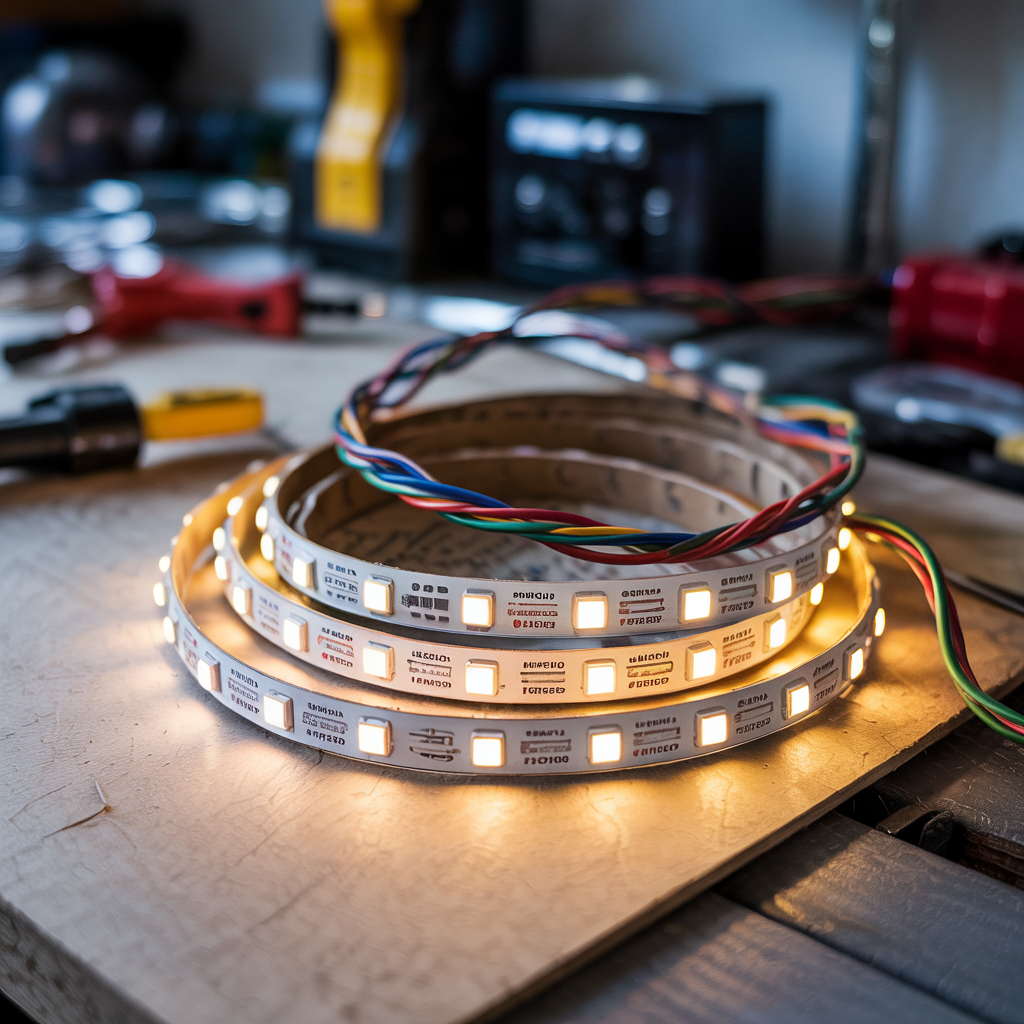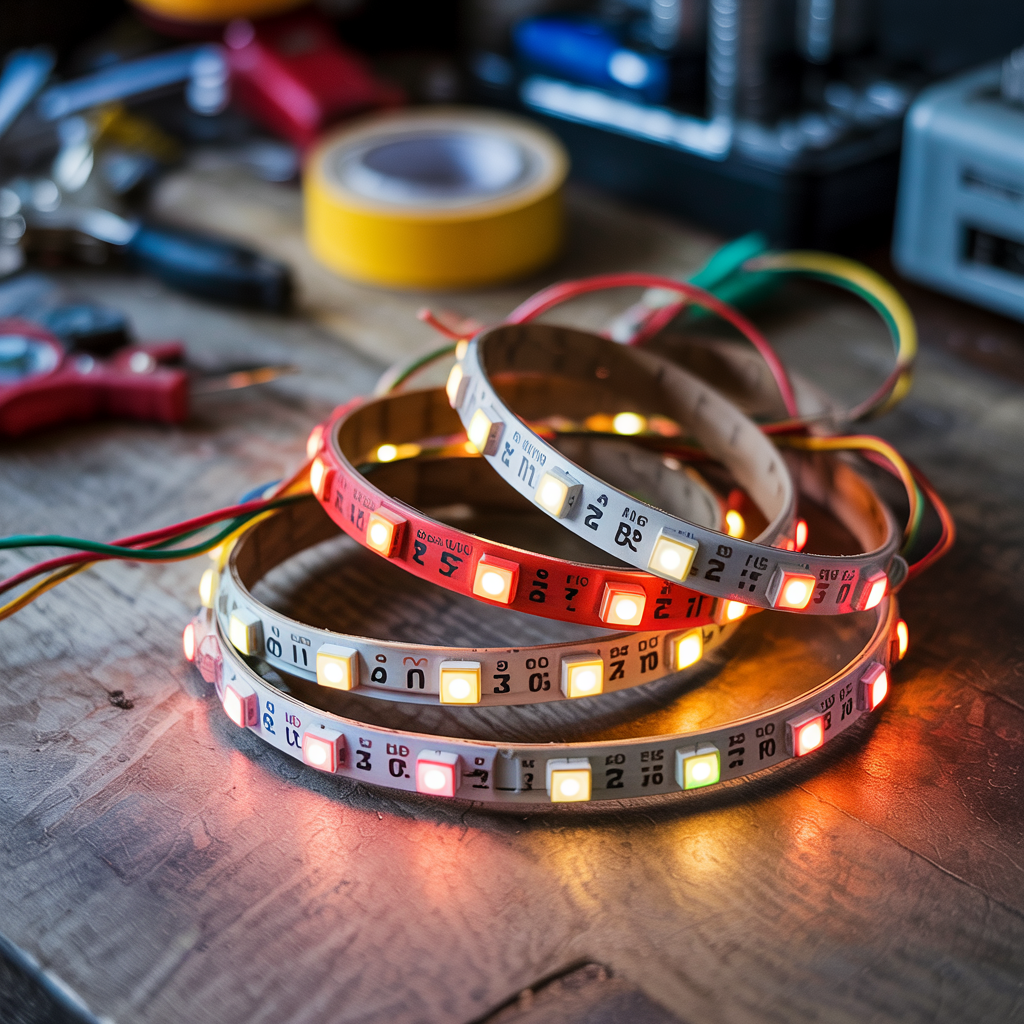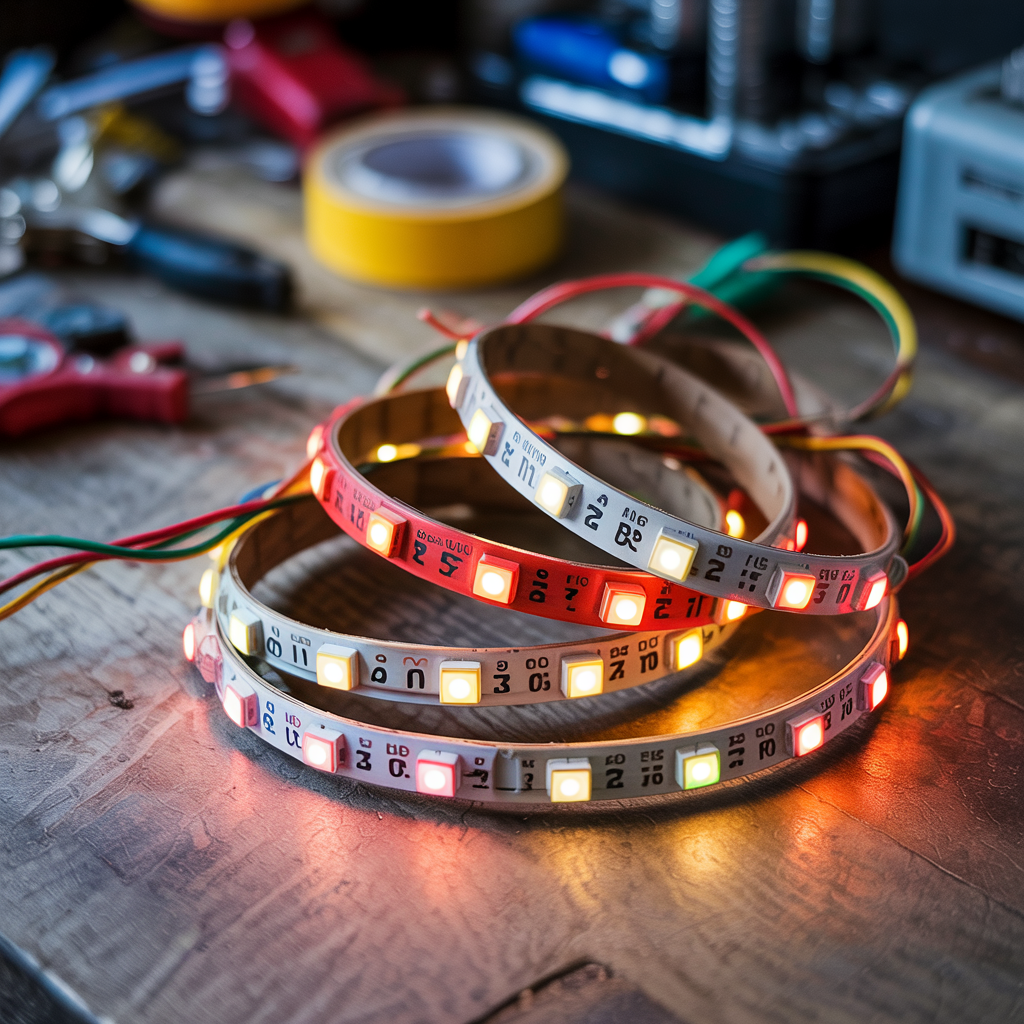How to Connect LED Lights Together Without Connector? A Simple Step Need To Follow
How to connect LED lights together without connector? Cut the strips on marked lines, scrape film, tin the + and – copper pads with rosin-core solder. Tin two short 22-AWG stranded wires, align strips pad-to-pad, solder positive to positive, negative to negative. Cover joints with heat-shrink or electrical tape to prevent shorts. Test with correct-voltage…
How to connect LED lights together without connector? Cut the strips on marked lines, scrape film, tin the + and – copper pads with rosin-core solder. Tin two short 22-AWG stranded wires, align strips pad-to-pad, solder positive to positive, negative to negative. Cover joints with heat-shrink or electrical tape to prevent shorts. Test with correct-voltage power supply.
Light-emitting diodes (LEDs) are semiconductor devices that emit light when an electric current passes through them. They are incredibly energy-efficient and long-lasting, making them a popular choice for various lighting applications. Understanding their basic electrical properties is crucial for connecting them without connectors.
LEDs come in various forms: single LEDs, LED strips, and LED bulbs. Single LEDs often require individual wiring, while LED strips usually have built-in circuitry. LED bulbs typically use a standard screw-in base. The method of connection without a connector varies significantly depending on the type.
How to Connect LED Lights Together Without Connector?

To connect LED lights together without a connector, solder the copper pads directly. Cut the strips at marked lines, tin the pads and wires with solder, and join positive to positive and negative to negative. Secure the connection with heat-shrink tubing or electrical tape to prevent short circuits. Always use a compatible power supply for safety.
Read More: Illuminating Your Space: A Comprehensive Guide On How To Attach LED Strip Lights
Connecting Single LEDs Without Connectors
Soldering: The Most Common Method
Soldering is a common technique to connect single LEDs. It involves melting solder to join the LED leads to the circuit. This requires a soldering iron, solder, and flux. This method allows for a clean and permanent connection but necessitates basic soldering skills.
Safety Precautions When Soldering
Always use appropriate safety equipment, including safety glasses and a well-ventilated workspace. Be cautious of the hot soldering iron and take your time to avoid burns or accidents. Using a soldering iron holder is highly recommended.
Understanding LED Polarity: Positive and Negative Leads
LEDs have polarity – a positive (+) and a negative (-) lead. Connecting them incorrectly can damage the LED. Identifying the positive and negative leads (often indicated by the longer positive lead or a marking on the LED package) is crucial before soldering or wiring.
Connecting LED Strips Without Connectors

Direct Wiring LED Strip Lights
Many LED strips have solder points that allow direct wiring. This bypasses the need for connectors, offering a cleaner look, especially in concealed installations. However, incorrect wiring can easily damage the LED strip.
Using Wire Nuts: A Simple, Safe Connection
Wire nuts provide a simple, screw-in method to securely connect the LED strip wires to your power source. This is a safer alternative to soldering for beginners. Ensure the wire nuts are correctly sized for the wire gauge.
Connecting LED Bulbs Without Connectors
Modifying Existing Fixtures
Modifying existing light fixtures to connect LED bulbs without a connector is generally not recommended unless you have electrical experience. Improper wiring can create fire hazards or electrical shocks.
Read More: How to Add LED Lights to Back of Mirror? A Comprehensive Guide
Advanced Techniques for Connecting LEDs Without Connectors

Using Wire Crimps
Wire crimps offer a quick and secure connection, especially in tight spaces. However, this method requires specialized tools and a certain level of dexterity.
Creating Custom Circuits: For the Experienced
For those with advanced electronics knowledge, building custom circuits can completely eliminate the need for connectors. This offers maximum customization but requires a deeper understanding of electronics.
Benefits of Connecting LEDs Without Connectors
Aesthetic Advantages: A Cleaner Look
Removing bulky connectors often results in a cleaner and more aesthetically pleasing lighting setup, especially in visible installations.
Cost Savings: Reduced Material Costs
Eliminating connectors can lead to reduced material costs, particularly for larger lighting projects. This is especially true for DIY projects.
Limitations of Connectorless LED Connections
Increased Difficulty: Requires Skill and Precision
Soldering and other connectorless methods require technical skills and precision. Mistakes can damage components or create safety hazards.
Maintenance Challenges: Harder to Repair or Modify
Directly wired LEDs are more challenging to repair or modify compared to those using connectors. Troubleshooting and maintenance can become more complex.
Choosing the Right Method
Beginner-Friendly Options: Wire Nuts and Pre-wired Strips
For beginners, wire nuts and pre-wired LED strips are the simplest and safest options.
Advanced Techniques: Soldering and Custom Circuits
Soldering and custom circuit building are suitable for those with electronics expertise.
Safety Precautions: Avoiding Electrical Hazards
Always Disconnect Power Before Working
This is the most crucial safety rule. Always disconnect the power supply before working with any electrical components.
Proper Insulation: Preventing Short Circuits
Use proper insulation techniques to prevent short circuits and electrical hazards. Ensure all connections are securely insulated.
Troubleshooting Common Problems
LEDs Not Lighting Up: Check Polarity and Connections
If your LEDs are not lighting up, double-check the polarity and ensure the connections are secure and properly insulated.
Flickering LEDs: Potential Wiring Issues
Flickering LEDs usually indicate loose connections or insufficient power supply. Inspect the wiring and check the power source.
Comparing Different Connection Methods
Cost, Difficulty, and Aesthetics
A comparison table can help you weigh the pros and cons of each method – soldering, wire nuts, crimps, and direct wiring.
Step-by-Step Guide: Connecting LED Strip Lights Without Connectors
Materials Needed: LED Strip, Wires, Soldering Iron (optional), Wire Nuts (optional)
This section provides a detailed step-by-step guide on connecting LED strips directly or using wire nuts, including visuals or diagrams.
Step-by-Step Guide: Connecting Single LEDs Without Connectors
Materials Needed: Single LEDs, Wires, Resistors (if needed), Soldering Iron, Solder, Flux
This section provides a detailed step-by-step guide on soldering single LEDs, including crucial safety precautions and illustrations.
Frequently Asked Questions
What are the risks associated with connecting LEDs without connectors?
Improper wiring can lead to short circuits, fire hazards, and electrical shocks. Improper insulation can cause failures.
Can I connect LEDs of different voltages together?
No, connecting LEDs of different voltages without proper current limiting is highly discouraged and can easily damage the LEDs.
How can I determine the correct resistor value for my LEDs?
The resistor value depends on the LED’s forward voltage and the supply voltage. Online calculators can help you determine the appropriate resistor.
What is the best way to insulate connections?
Use heat-shrink tubing or electrical tape to properly insulate the connections. Heat-shrink tubing provides a more durable and secure seal.
What are the long-term effects of improperly wired LEDs?
Over time, improperly wired LEDs may experience premature failure due to overheating or voltage surges. This can lead to potential safety risks if not addressed.
What should I do if my LED lights are not working after connection?
First, check the power supply, then examine all connections for any loose wires or damaged parts. Verify polarity for single LEDs. If all is sound, consult an electrician.
Final Thoughts
Connecting LED lights without connectors offers a cleaner aesthetic and potentially cost savings. However, it necessitates a good understanding of basic electrical concepts and the ability to execute the chosen method correctly. Whether you choose soldering, using wire nuts, or another approach, always prioritize safety. Thoroughly inspect your work, and if you are uncomfortable working with electricity, always consult with a qualified electrician. Remember, while the cost savings might be attractive, compromising safety is never worth it. By carefully following the steps outlined and exercising caution, you can successfully connect your LED lights without connectors and enjoy the stunning results of your project.

